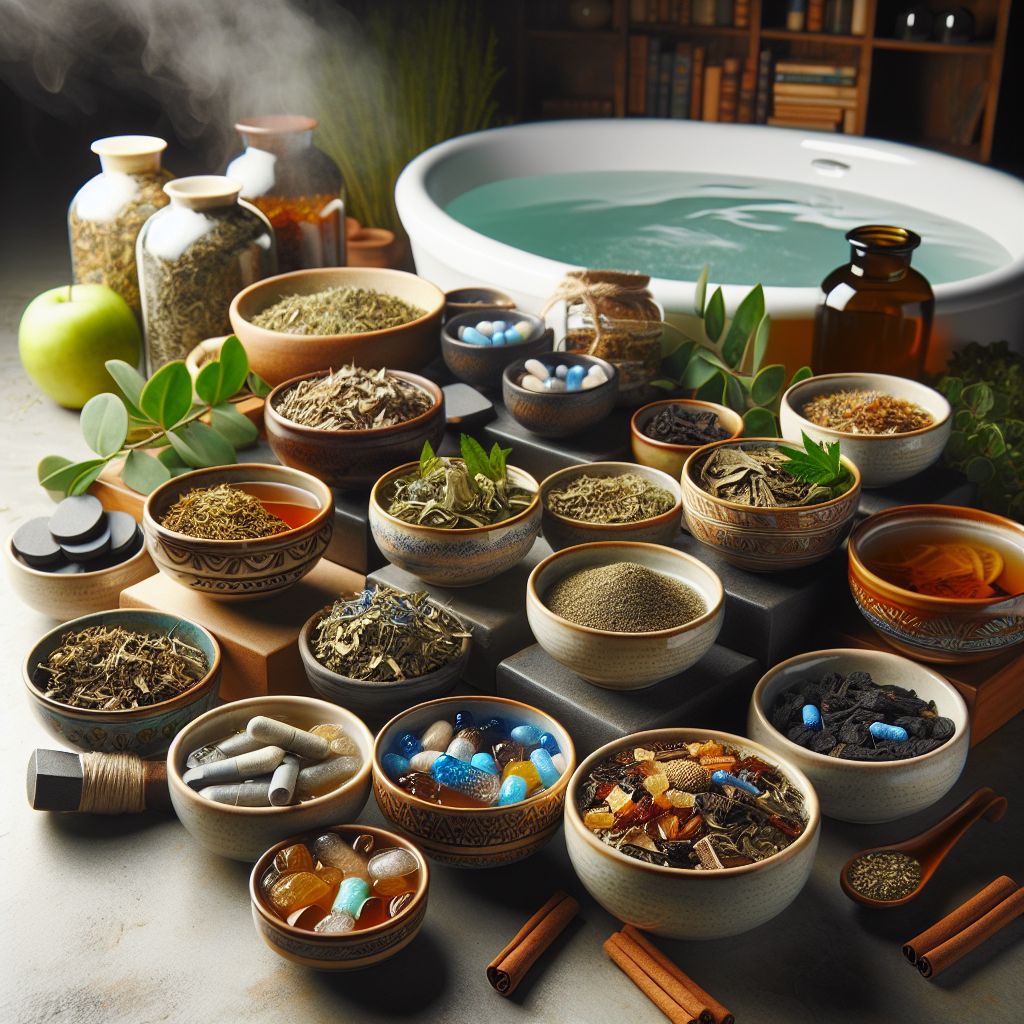
-
Herbal infusions can naturally support blood sugar management in diabetes.
-
Hydrotherapy baths offer potential benefits such as improved circulation and relaxation.
-
Combining herbal infusions with hydrotherapy can enhance overall wellness for diabetics.
-
It’s crucial to understand safe practices and consult with healthcare providers before starting.
-
Personal experiences and scientific research support the use of these natural therapies for diabetes care.
Tapping into Nature’s Bounty: Herbal Infusions for Blood Sugar Control
When you’re managing diabetes, every little bit of natural support counts. Herbal infusions are like a secret garden of remedies, offering a gentle nudge to your body’s own healing mechanisms. Imagine sipping on a warm, soothing brew that not only calms your spirit but also works silently to balance your blood sugar levels. This isn’t a far-fetched dream; it’s the reality of what herbal teas can offer.
The Power of Herbs: A Brief Overview
For centuries, people have turned to the healing powers of herbs. These plants are packed with compounds that interact with our bodies in subtle, yet profound ways. In the case of diabetes, certain herbs have been shown to help manage blood sugar levels. They do this by stimulating insulin production, improving insulin sensitivity, or slowing down the absorption of sugar in the intestines.
Crafting Your Own Diabetes-Friendly Brew
Creating your own herbal infusion is simple and empowering. You’ll need to select herbs that are known for their blood sugar regulating properties. Then, steep them in hot water to extract those beneficial compounds. Here’s how to do it:
-
Choose your herbs: Pick one or a combination of diabetes-friendly herbs.
-
Boil water: Bring water to a rolling boil in a kettle.
-
Steep: Add the herbs to a teapot or a cup and pour the hot water over them. Let them steep for 5 to 10 minutes.
-
Strain and enjoy: Pour the infusion through a strainer into your cup and enjoy.
Top Herbs Known to Support Diabetic Health

Let’s dive into some of the most effective herbs for diabetes:
-
Cinnamon: Known for its ability to lower blood sugar and improve insulin sensitivity.
-
Fenugreek: High in soluble fiber, which helps control blood sugar levels.
-
Ginseng: May improve pancreatic cell function and boost insulin production.
-
Bitter Melon: Contains compounds that act like insulin and help lower blood glucose levels.
-
Gymnema Sylvestre: Helps reduce sugar absorption in the intestines and improve insulin function.
Remember, while these herbs are helpful, they’re part of a larger diabetes management plan that includes diet, exercise, and possibly medication. Always talk to your healthcare provider before adding new herbs to your regimen, especially if you’re on medication, as some herbs can interact with drugs.
Combining Forces: Integrating Herbal and Hydro Therapies
Imagine a dual approach to diabetes management that not only helps in regulating blood sugar levels but also soothes the mind and body. This is where the magic of combining herbal infusions with hydrotherapy shines. It’s a holistic strategy that leverages the best of both worlds—natural herbal remedies and the therapeutic properties of water.
Integrating herbal and hydrotherapy isn’t just about physical wellness; it’s about creating a routine that nurtures the body and the soul. When you sip on a cup of herbal tea, you’re ingesting nature’s finest ingredients for blood sugar control. And when you submerge yourself in a hydrotherapy bath, you’re allowing your body to relax and rejuvenate, which is essential for stress management—a key factor in diabetes care.
Together, these therapies can form a synergistic routine that supports your diabetes management plan. They complement each other, with the herbs targeting blood sugar levels internally and the hydrotherapy addressing the external factors such as stress and circulation.
Creating a Synergistic Wellness Routine
To create a routine that incorporates both herbal infusions and hydrotherapy, start by identifying the times of day when you can consistently dedicate a moment to self-care. Perhaps it’s a calming herbal tea in the morning to kickstart your day, followed by a hydrotherapy bath in the evening to wash away the day’s stress and prepare for a restful night’s sleep.
Personalizing Your Treatment: Tips and Tricks
Personalization is key. While there are general guidelines for using herbs and hydrotherapy, the most effective routine is the one that resonates with your personal preferences and lifestyle. Here are some tips to tailor your experience:
-
Listen to your body: Pay attention to how you feel after each therapy and adjust accordingly.
-
Vary your herbs: Rotate between different herbs to find the blend that works best for you.
-
Adjust water temperature: Some find relief in warm water, while others prefer cooler temperatures. Experiment to find your comfort zone.
-
Set the mood: Enhance your hydrotherapy experience with calming music or dim lighting to create a spa-like atmosphere.
Monitoring Progress: When to Expect Results
As with any new health routine, it’s important to monitor your progress. Keep track of your blood sugar levels, stress indicators, and overall well-being. You might start noticing improvements in your blood sugar control and stress levels within a few weeks. However, remember that these natural therapies are part of a long-term wellness journey.
It’s also important to maintain open communication with your healthcare provider. They can help you interpret the changes you’re observing and adjust your diabetes management plan as needed.
Precautions and Pro Tips for Optimal Safety and Efficacy
As with any therapy, safety comes first. Here are some precautions to ensure you’re getting the most out of your herbal and hydrotherapy routines without putting your health at risk:
-
Consult your healthcare provider before starting, especially if you’re on medication.
-
Test the water temperature to prevent burns or discomfort.
-
Start with shorter sessions and gradually increase as you become more accustomed.
-
Be aware of any allergic reactions to herbs and stop use immediately if any adverse effects occur.
Navigating Contraindications: What to Watch Out For
While herbal and hydrotherapy treatments are generally safe, there are certain situations where they may not be recommended. For instance, if you have neuropathy, a common complication of diabetes, you should be extra cautious with hydrotherapy, as it may be harder to gauge water temperature and prevent burns.
Additionally, some herbs can interact with diabetes medications, potentially leading to hypoglycemia. Always inform your healthcare provider about any herbs you’re considering so they can guide you on safe usage.
With these tips and precautions in mind, you’re well on your way to creating a soothing and healthful routine that supports your diabetes management. Embrace the calming power of herbal infusions and the therapeutic benefits of hydrotherapy, and watch as they transform your diabetes wellness journey.
Maximizing Benefits: Best Practices in Herbal and Hydrotherapy
For maximum benefit, consistency is key. Establish a routine that incorporates both herbal infusions and hydrotherapy into your daily life. Consider the timing of these practices—perhaps a herbal tea in the morning to stabilize your blood sugar from the start, and a hydrotherapy session in the evening to promote relaxation and better sleep.
FAQ: Diving Deeper into Diabetic Hydrotherapy

When it comes to managing diabetes, every question answered can lead to a more informed and healthier lifestyle. Let’s address some common queries about hydrotherapy and herbal infusions for diabetes management.
1. Can hydrotherapy alone effectively manage diabetes?
While hydrotherapy can be a beneficial part of a diabetes management plan, it should not be used as the sole treatment method. It is most effective when combined with a balanced diet, regular exercise, and any medications prescribed by your healthcare provider.
2. What types of herbs are safe for diabetics to use in infusions?
Many herbs can be safe and beneficial for diabetics, such as cinnamon, fenugreek, and bitter melon. However, it’s important to consult with a healthcare provider before adding new herbs to your diet, especially if you’re on medication, as some herbs can interact with drugs.
3. How often can I take a hydrotherapy bath as a diabetic patient?
Start with hydrotherapy sessions once or twice a week, observing how your body responds. If you find it beneficial and have no adverse reactions, you can gradually increase the frequency. Always listen to your body and ensure the practice complements your overall diabetes management plan.
-
Consult with a healthcare provider before starting hydrotherapy.
-
Test the water temperature to prevent burns.
-
Begin with shorter sessions and gradually increase the duration.
-
Monitor blood sugar levels to observe the effects of hydrotherapy.
4. Are there any side effects of herbal infusions on diabetic medication?
Some herbal infusions can interact with diabetic medications and potentially cause side effects such as hypoglycemia. Always inform your healthcare provider about any new herbal remedies you’re considering to avoid any negative interactions with your medications.



Leave a Reply